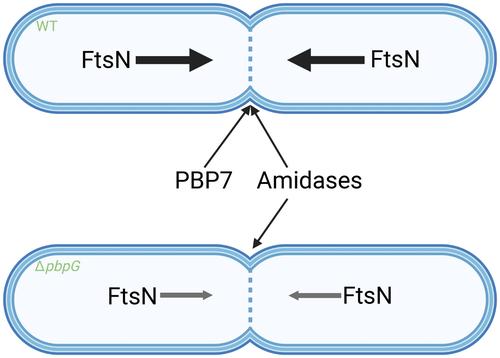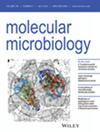肽聚糖内肽酶 PBP7 在大肠杆菌中促进 FtsN 向分裂体的招募并促进肽聚糖的合成
IF 2.6
2区 生物学
Q3 BIOCHEMISTRY & MOLECULAR BIOLOGY
引用次数: 0
摘要
大肠杆菌有许多外质水解酶来降解和修饰肽聚糖(PG)。然而,由于八种 PG 内肽酶的冗余性,给单个酶定义特定作用具有挑战性。因此,PBP7(由 pbpG 编码)的细胞作用尚未明确界定。在这项研究中,我们发现 PBP7 定位于细胞侧膜和细胞中部。PBP7 的 C 端 α-helix 对其在细胞中部的定位至关重要,但对其活性并不重要,因为其活性对于这种定位是可有可无的。此外,PBP7 的中细胞定位依赖于 FtsZ 在分裂体中组装到 FtsN,也依赖于 PBP3 的活性。研究发现,PBP7 会影响 FtsZ 和 FtsN 在分裂体中的组装时间。PBP7 的缺失会减缓 FtsN 在细胞中期的组装。与野生型细胞相比,ΔpbpG突变体的荧光D-氨基酸HADA掺入量较低,这表明其具有转肽酶活性。这可能表明ΔpbpG 突变株隔膜的 PG 合成减少,从而解释了 FtsN 累积较慢的原因,并表明内肽酶介导的 PG 裂解可能是隔膜 PG 合成的限速步骤。本文章由计算机程序翻译,如有差异,请以英文原文为准。

Peptidoglycan Endopeptidase PBP7 Facilitates the Recruitment of FtsN to the Divisome and Promotes Peptidoglycan Synthesis in Escherichia coli
Escherichia coli has many periplasmic hydrolases to degrade and modify peptidoglycan (PG). However, the redundancy of eight PG endopeptidases makes it challenging to define specific roles to individual enzymes. Therefore, the cellular role of PBP7 (encoded by pbpG) is not clearly defined. In this work, we show that PBP7 localizes in the lateral cell envelope and at midcell. The C-terminal α-helix of PBP7 is crucial for midcell localization but not for its activity, which is dispensable for this localization. Additionally, midcell localization of PBP7 relies on the assembly of FtsZ up to FtsN in the divisome, and on the activity of PBP3. PBP7 was found to affect the assembly timing of FtsZ and FtsN in the divisome. The absence of PBP7 slows down the assembly of FtsN at midcell. The ΔpbpG mutant exhibited a weaker incorporation of the fluorescent D-amino acid HADA, reporting on transpeptidase activity, compared to wild-type cells. This could indicate reduced PG synthesis at the septum of the ΔpbpG strain, explaining the slower accumulation of FtsN and suggesting that endopeptidase-mediated PG cleavage may be a rate-limiting step for septal PG synthesis.
求助全文
通过发布文献求助,成功后即可免费获取论文全文。
去求助
来源期刊

Molecular Microbiology
生物-生化与分子生物学
CiteScore
7.20
自引率
5.60%
发文量
132
审稿时长
1.7 months
期刊介绍:
Molecular Microbiology, the leading primary journal in the microbial sciences, publishes molecular studies of Bacteria, Archaea, eukaryotic microorganisms, and their viruses.
Research papers should lead to a deeper understanding of the molecular principles underlying basic physiological processes or mechanisms. Appropriate topics include gene expression and regulation, pathogenicity and virulence, physiology and metabolism, synthesis of macromolecules (proteins, nucleic acids, lipids, polysaccharides, etc), cell biology and subcellular organization, membrane biogenesis and function, traffic and transport, cell-cell communication and signalling pathways, evolution and gene transfer. Articles focused on host responses (cellular or immunological) to pathogens or on microbial ecology should be directed to our sister journals Cellular Microbiology and Environmental Microbiology, respectively.
 求助内容:
求助内容: 应助结果提醒方式:
应助结果提醒方式:


